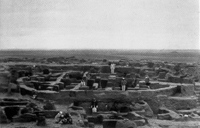
Located in northwestern Iraq near the modern city of Mosul, and not far from ancient Nineveh, Tepe Gawra was excavated by the University Museum from 1931 to 1938. The site was continuously occupied from the Halaf Period (c. 5000–c. 4300 B.C.) to the middle of the 2nd millennium B.C., and gives its name to the Gawra Period (ca. 3500-2900). During the fourth millennium the site appears to have been the ceremonial and administrative center of a small, somewhat peripheral polity in the piedmont of northern Iraq. In varying degrees from level to level, the site's residents also engaged in craft production, including cloth manufacture, pottery making, wood working, bone/stone bead and seal carving, ground stone and lithic tool manufacture, and, perhaps, ran a small, central market place.
